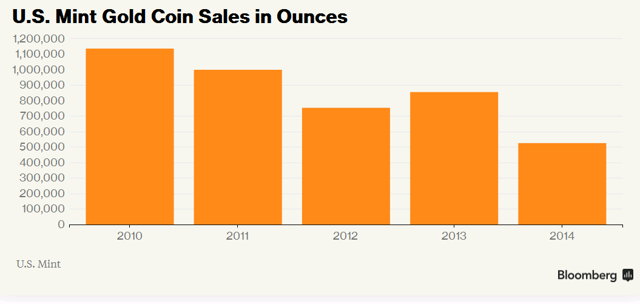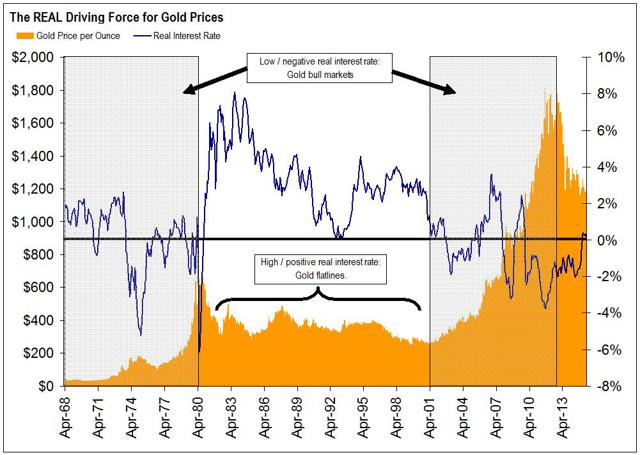The Next Gold Bull Market
Summary
- The gold bull market died in 2011.
- Die hard supporters are throwing in the towel.
- Investors seeking the next gold bull market need to watch one key variable.
Even the most ardent supporters - buyers of physical bullion and coins - have scattered. US Mint gold coin sales have dropped in half since 2010 (see chart from Bloomberg below).
(click to enlarge)

Physical dealers are feeling the hit. From a recent Bloomberg article:
"Some of the coin buyers are the diehard believers in gold, and seeing them stay away from the market means their faith may have been shaken," said Phil Streible, a senior market strategist at RJO Futures in Chicago who has been following prices for 15 years. "Demand for all kinds of physical gold products has taken a hit."Why Did the Gold Bull Market Die?
After all, weren't pundits calling for $3,000, $5,000, $10,000 gold? The arguments all seemed quite rationale. Here are a few popular ones:
- Gold-to-DJIA Ratio: At the peak of the 1970s gold bull market the ratio approached 1. People argued that we wouldn't see another peak until the gold-to-DJIA ratio again approached this level.
- Massive Money Printing: People pointed to the huge growth in assets bought and held by the Federal Reserve as an eventual trigger for runaway inflation.
- Debt-to-GDP Ratio: Some argued that the public debt-to-GDP ratio would eventually destabilize the financial system as government debt is monetized (see point 2 above).
The 'real interest rate' is the rate on a risk-free asset, adjusted for inflation. There are different measures, but one example is the 1yr US Treasury [1-3yr US Treasury ETF (NYSEARCA:SHY)] yield minus the 1yr change in CPI. Real interest rates can swing from positive to negative, depending on the economic environment. These rates say a lot about the state of the markets.
A negative real interest rate implies that investors are not adequately compensated for investing in US Treasuries. This makes US Treasuries less attractive to investors seeking safety.
In contrast, a positive real interest rate suggests that US Treasury investors are staying ahead of inflation. This makes US Treasuries more attractive to investors seeking safety.
As you have probably surmised, the appeal of gold (any asset, for that matter) is partly derived from the relative appeal of competing assets. For those that view gold as a safe haven, US Treasuries will become more attractive as real interest rates rise.
The chart (data source: St Louis Fed) below compares the real interest rate (right scale) to the price of gold (left scale). Real interest rates bottomed in September 2011 and have risen ever since. With this rise in real interest rates, gold became less attractive relative to other safe havens and has since collapsed by 40%.
Going back further, you can see the relationship between real interest rates and gold prices is fairly strong:
- During the gold bull market that ended at the end of the 1970s, real interest rates were low / negative.
- During the gold bear market from the early 1980s to the early 2000s, real interest rates were high / positive.
- Finally, during the gold bull market from the early 2000s to 2011, real interest rates were low / negative.

Conclusion
Investors watching gold today need to pay attention to real interest rates. If the real interest rate continues to strengthen, the relative attractiveness of gold will continue to erode. I believe the next gold bull market will occur when there is a clear and lasting indication that real interest rates are headed towards negative territory.

0 comments:
Publicar un comentario